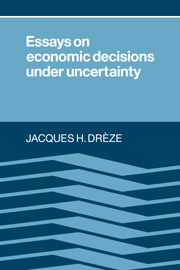Book contents
- Frontmatter
- Contents
- Acknowledgements
- Foreword
- I Decision-making under uncertainty: general theory
- II Markets and prices
- III Consumer decisions
- IV Producer decisions
- V Theory of the firm
- 14 Investment under private ownership: optimality, equilibrium and stability
- 15 Decision criteria for business firms
- 16 (Uncertainty and) the firm in general equilibrium theory
- IV Human capital and labour contracts
- VII Public decisions
- Index
16 - (Uncertainty and) the firm in general equilibrium theory
Published online by Cambridge University Press: 01 October 2009
- Frontmatter
- Contents
- Acknowledgements
- Foreword
- I Decision-making under uncertainty: general theory
- II Markets and prices
- III Consumer decisions
- IV Producer decisions
- V Theory of the firm
- 14 Investment under private ownership: optimality, equilibrium and stability
- 15 Decision criteria for business firms
- 16 (Uncertainty and) the firm in general equilibrium theory
- IV Human capital and labour contracts
- VII Public decisions
- Index
Summary
The firm fits into general equilibrium theory as a balloon fits into an envelope: flattened out! Try with a blown-up balloon: the envelope may tear, or fly away: at best, it will be hard to seal and impossible to mail…. Instead, burst the balloon flat, and everything becomes easy. Similarly with the firm and general equilibrium – though the analogy requires a word of explanation.
General equilibrium theory – GET for short – has two attributes. First, it defines clearly the boundary between economic analysis and the exogenous primitive data or assumptions from which it proceeds; that is, it defines a precise, self-contained ‘model’. Second, it verifies the overall consistency of the economic analysis. A natural step in verifying overall consistency is to exhibit sufficient conditions for the existence of the proposed solutions, or ‘equilibria’. This step is usually amenable to mathematical reasoning.
Still, I do not mean to identify general equilibrium theory with that potent cocktail of economics and mathematics known as mathematical economics. (To some, mathematical economics is merely a pleonasm; to others, it is a branch of mathematical pornography; the word cocktail, with its element of pornographic pleonasm, is purposely neutral.) Work in mathematical economics lacking the GET–attributes is abundant.
- Type
- Chapter
- Information
- Essays on Economic Decisions under Uncertainty , pp. 321 - 344Publisher: Cambridge University PressPrint publication year: 1987
- 2
- Cited by

